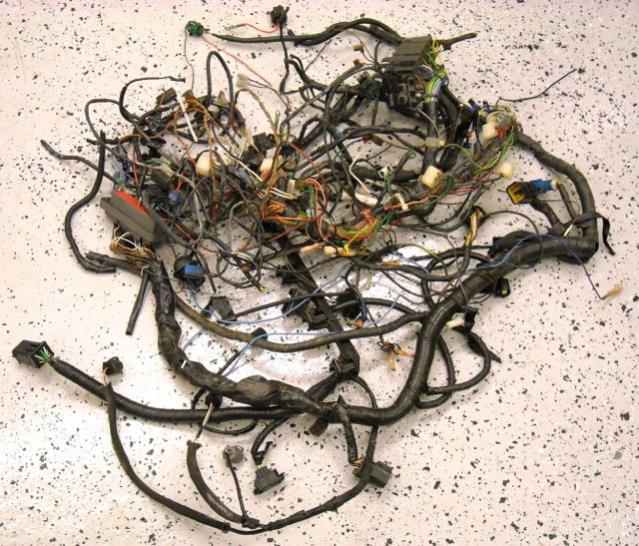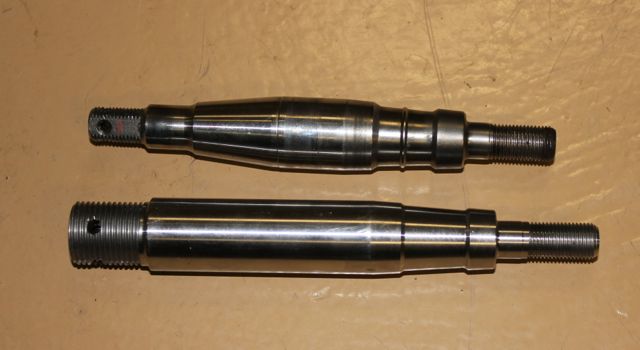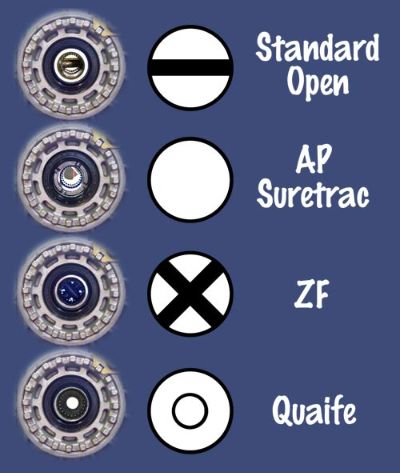-
Posts
147 -
Joined
Content Type
Profiles
Forums
Store
Articles
Gallery
Events
Library
Everything posted by dallasdude
-
Professional race harnesses are usually made from a high quality shrink tubing such as Raychem DR-25. Home harnesses are made quite often with convoluted tubing or expando and garden variety shrink tubing. Cheaper and requires less planning especially with convoluted because you can go back and make changes to correct your mistakes and make updates....but not the pro way to do things. BTW the harness I pictured in the thread is not one I built....it's the one that came out of one of my cars and went in the trash.
-
-
I wanted to correct one thing....I did see a replacement front hub for the smaller (pre-2003) spindle on the Caterham site. It is aluminum not steel. I also took a picture of the older and newer style (larger) spindles side by side.
-
The 2003 and up Caterham spindle is far far larger than the Spitfire one. I think Dave Bean's theory is a smaller spindle leaves more room for the bearings and seals..and they have a point. The Spitfire size spindle also uses bearings that are much more readily available. The large (later Caterham) spindle and hub uses a bearing that is similar to one available from third parties (used on a lot of utility trailers), but without the built in lip seal they use with this setup due to limited space. So from the way I understand it, there are three setups. 2002 and earlier Caterham Dave Bean compatible upgrade for above 2003 and up Caterham....which requires everything. Spindles, hubs, bearings, nuts and spacers. Caterham does not sell the old style hubs anymore and this is the replacement from their standpoint.
-

NEEDED: deDion Tube, A-Frame, Radius Arms
dallasdude replied to werthie's topic in Parts For Sale / Wanted
I am working on a jig to be certain the two extras tubes I have are straight. I will possibly sell one of them then. -
I am not sure you can still order Zetec cam gears from Esslinger. I think they still make them, but make you buy them through ZX Tuner. Esslinger was involved in Zetecs several years back, but got back their roots which is Pinto based engines. I probably have a couple sets lying around if you can't find elsewhere.
-
To put the Blatchat posts in perspective....a lot of these cars are 15 years old or older and had a lot of miles on poor roads in bad weather. In some cases rust is the culprit. That said, what you want on a high powered Caterham that is tracked is a wide buttress version 7 De Dion tube. I don't know what the crossover date is, but any car built 2003 or earlier is not going to have it unless it has been upgraded. The later ones made with two shock mount positions are acceptable for most applications, but not as good as the wide buttress single shock mount. I suspect your damage was not from when it was pulled up on the flatbed, but when it was tied down. The wrecker driver probably looked up underneath the back the biggest thing he saw was the De Dion tube. Like a live axle American car, the tube is connected directly to the tires....with no spring in between, so when he winches it down to hold it, the tube I believe in your case distorted. Problem is the tube is not as strong as what is his used to, and probably used a hook or chain instead of an axle strap, creating a stress point. The triangles can be straightened in some cases. The trailing arms maybe are not bent, but you might find someone who has upgraded to the Watts link and has their trailing arms lying around.
-
I will try to post some pictures later today. I would think they could be straightened but would be concerned about them maintaining shape. And you would need a jig or fixture to be sure the ends are parallel. The bottom line is when you try to do an alignment, but you don't want to have to put everything together to see that you have straightened it correctly. I believe there is an old blatchat thread that describes the revisions of the tube if anyone has the link.
-
The older dedion tubes are pretty easy to bend, although I doubt being on jack stands did it...there are about seven revisions of the tube and of course later is better. It's possible your ears are bent (the aluminum ones that attach to the ends of the tube), but more than likely it's the tube itself. I have been meaning to make to go/no go fixture to check the tubes for straightness. As far as the 2 degrees camber, the your car probably came with .8 degree (approx) camber ears. Don't know if someone switched them out or here again your tube is bent. The are some 1.5 degree ears. The are some ears with more camber than that, but they don't work with the Sierra calipers. Two degrees is desirable for track use with radials, but might lead to excessive tire wear on the street. If your figures are correct, the reply was correct there is no way you can make that up with shims and have it maintain alignment. You're gonna have to buy a new tube. Be careful the latest tubes (made after about 2005 I think) ,may not have a shock mount in the correct place to make your shocks useable. Yours probably came with a shock mount that goes through the center of the tube, later ones eliminated that mount (I guess it compromised the strength) and only used the shock mount that was underslung to the tube. Someone may have direct experience but this moves the shock mounting point down a couple inches, possible requiring a longer shock.
-
This is right on......the Titan is preferred for actual competition use. It is a clutch type. Torsens like the Quaife are quiet and trouble free and a great limited slip until they aren't....as in when you run over a curb and that wheel goes light. At a point (Taylor says 20%) when a wheel is unloaded it acts like an open dif. It's probably a great choice for combination track/street usage. I know at one time Taylor Race Engineering was working on somthing to put in the Formula SAE Quaife units to overcome this tendency. There is no special setup on a Titan. You order it from Redline and install and set up the diff like any other. Or I believe they will sell you a complete dif.
-
The ones to be careful with are the hard lines on the rear. Metric on the Sierra caliper end, SAE on the union in the middle. It takes either a factory brake line or a custom made one to get the flares and fittings correct.
-
I only met Woody Adams once, at the Fourth of July race at High Plains. I walked by on Sunday and he was struggling with a small issue on this car. I told him I would come back and help after I finished up a wheel bearing on my car which was at the other end of the paddock. Bottom line.....I came back half an hour or so later and the old guy in the VFW hat had loaded up and headed back for South Dakota. One my greatest regrets is I didn't drop everything and help him right then.
-
Yes quite a bit of money for a Zetec car even with a six speed. I have a friend who does software for salvage auction companies. It's a big business and you would be surprised what the salvage cars bring. One of the companies he worked for would auction hundreds of cars every Thursday and there are many locations across the country that are that size. You wonder where all the cars with salvage titles go. The stuff that is wrong with flood damaged cars is not always what you might think. The driveline itself is sealed pretty well because of emissions if nothing else. Its the electronics on most modern cars that give problems. I bought an E46 BMW that was flood damaged. Replaced the seat motors, air bag computer, alternator and idler (bearings). Then I drove it 90K miles without a problem. Had to dry or replace the ABS/DSC sensors too. Luckily the electronics on a 7 are pretty simple and made to be installed/replaced after the car leaves the factory. I can't speak to drying out the frame however.
-
They made a 8% left hand drive wide track rack, but I think it has been out of production for a while. The part # is on the bottom of the rack. I had it but can't find it now, but yes you can use the normal rack with the extenders. I believe my early 2000 car came with and 8%, the 2002 with a 22% both from the factory kit. You might want to order a couple of the bump steer shims that go under the rack while you are at it. Pretty easy to make out of aluminum strip also.
-

which widetrack front suspension should i get?
dallasdude replied to MNlotus's topic in General Tech
The guys from Blatchat are right about not using the rear bar. I think the red bush front bar and no rear bar is a good combination, except maybe for autocross. I never liked the geometry of the rear bar, and it can contribute to wheelspin on the inside wheel coming off a corner because it is limiting the droop of that wheel. The downside is no balance adjustment because the front bar is not adjustable. -

which widetrack front suspension should i get?
dallasdude replied to MNlotus's topic in General Tech
The green bush bar might be a little much unless you have a rear sway bar. I think the rear bar was an option at one time. I second the not spending the money on brakes. The stock 14LF calipers are not extremely light or stiff compared to some modern calipers, but they are adequate. Plenty of pads and repair parts available. The Spitfire (stock) rotors.....there are drilled and slotted ones available who look sexier but probably don't work any better I suspect. And they cost way way more. The updated front spindles and hubs are something to consider, although I think they are a little bit of a mixed blessing. The spindle is far far larger and flexes less, but the bearings are no bigger...might even be smaller and they are harder to find. -

New 2.3L Duratec Cylinder Head for Sale
dallasdude replied to gpwerks's topic in Parts For Sale / Wanted
If anyone is interested in a used Ranger (23NS) short block to go with it we have one for a reasonable price. -
Yes the standard Zetec flywheel has a 36-1 trigger on it, and if the software has an option use 36-1 and magnetic for the trigger. There is also an intake cam sensor (exhaust on the VCT). You will need to use this if you are going to use the injection in full sequential mode. Batch or semi sequential do not require it. The standard ignition is wasted spark, so it doesn't require it either. Individual coil systems would.
-
I thought they had changed to BMW's also, but I was with a dealer with two new Caterhams over the weekend....and the diffs were definately Sierras. This image is from Road and Race and shows the types, but requires you remove an axle to look inside. If you jack up one wheel with a torsen (Quaife).....it will just roll freely like an open dif. Chart does not show a Titan, but I doubt many Caterhams in the US have them.
-
I spoke with Mick with Redline this morning and he says they have one left side remaining, and no right sides for 2 or 3 weeks. The usually get 50 pairs, but the last shipment was all left sides and no right sides, who ever does the assembly must have been missing one of the parts that was different (the length of the shaft itself is different and the threads on the end of the axle nut are different). He said the CV joints are Ford Sierra or Cosworth pieces, in fact when the started to convert to the de dion in the 80's they just got the whole Sierra axle and cut it down to make it work. GNK may very well be where Ford buys them from. Don't know if Caterham buys from Ford or GNK or most likely has a third party make up the assembly with the axles. When we get the rebuild kits from Redline with the boots and clips, the grease is in a Ford packet. (which ironically we throw away and use Redline grease from the US).
-
The standard front calipers are a Girling 14LF. Used on various BMC cars and a lot of vintage formula fords. The pads are also the same as a Formula Mazda. Pegasus and Moss Motors keep pads and repair parts. Pegasus also sells a ICP caliper that might make a good replacement for the Girling one. Not only stiffer but lighter for less unsprung weight. I have not tested them for fit however and it does use a little different pad. I wouldn't bother for an occasional track car if your calipers are in good shape. I don't know if the European Sierra rear calipers are the same as a Merkur or not. Hawk and Carbotech both have upgraded pads for the front and rear, but they are not cheap. Go ahead and replace the rotors too if they have any wear at all. They are cheap. I order the better of the two qualities they have for a Spitfire a Moss Motors. Less than 30 bucks each. Same front and rear. I have a couple brand new sets of "Delphi" pads I need to sell. Came as spares with a track car. The look fine but they are not what I am standardized on. I will sell for half what a full set of Carbotechs cost...which with cores for the rear is close to 300 bucks.
-
Don't know where you are in Arkansas but I would think maybe Hallett outside Tulsa would be a similar distance or closer. It is a wonderful little track.....great for seven type cars. They run a monthly series called COMMA with which is pretty inexpensive. The track and the series are run by the Stephens family and they do a great job.
-
Those are tripod type....the later ones. I think the changeover was 03 or 04. I have rubber boot kits for then, but not extra internal pieces or ends. The can type has a sheet metal piece (about the size of a fat soda can) that holds the boot. The boots are not interchangeable. The internal internal balls might be interchangeable but not the end pieces or boots. You can of course interchange the whole axle styles...and I think if you order new ones you get tripod style. Well if you can get them that is.
-

FS: 2001 Caterham 7. BRGw/yellow stripe. $24,900. FL
dallasdude replied to wirewheel's topic in Cars For Sale
He's an article Craig Taylor (now retired) did several years ago about differnentials. http://www.taylor-race.com/pdf/understanding_differentials.pdf As far as I know there are four types available for the Sierra 7" diff. Open of course (no limited slip). You can manage your traction with the suspension. Eric Prill almost won a national championship with and Lotus 7 with an open diff....by limiting droop in the front suspension. But that was a low torque car. Cam and Pawl. A lot the limited slips in Caterhams especially older ones use an AP Suretrac which is this design. I really works ok. Unless you making big power they are pretty dependable in a Caterham. Almost all the cars delivered from 99-2002 for the Caterham Championship Series had these. Clutch type. These are Lockheed or Titan. They do have clutches that wear, but from what I understand the Lockheeds last forever. Torsen (ATB) Quaife uses this....and it is a widely used, trouble free and quiet design. There are no friction surfaces to wear. Mazda has used it for the Miata LSD's since 93 and they take a huge amount of abuse in Spec Miata. Only downside is they are a limited slip until they aren't. If the inside wheel becomes too lightly loaded (I think the article says 20%), the mechanism directs the power there. I think there was been some work done to minimize this. All around it is the best choice for street usage, and the limitation doesn't seem to keep people from hustling around Spec Miatas pretty quickly. I would say the fact this car has a Quaife is a pretty big positive. It should not be any noisier or require more maintenance than an open diff, but provide a substantial improvement in traction.




